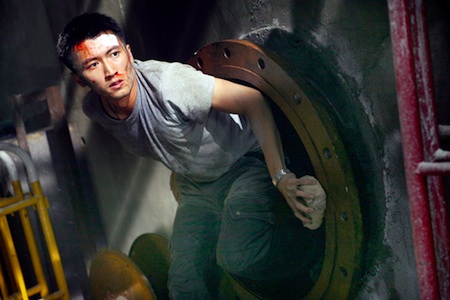Dante Lam’s Beast Stalker is an oddity in the Hong Kong action genre. You won’t find the lyrical bloodshed of John Woo or the magical kinetics of Tsui Hark. Instead, Lam envisions a chaotic world set in motion by chance, where themes of revenge and redemption are intrinsically tied to the fateful criss-cross of characters in distress. This approach dominates Beast Stalker’s dynamic opening sequence, where Sgt. Tong (Nicholas Tse) and his partner pursue a trio of armed robbers through the crowded city streets. The fast-paced scene culminates in a brutal three-car collision that focuses intensely on the impact and aftermath of random violence. Quick cutting, slow-motion shots, and jarring sound effects mesh together to bring the severity of this moment to life.
Much of Beast Stalker unfolds in similarly blunt force fashion, relying heavily on extreme action aesthetics to convey the film’s primary theme: merciless pursuit. But one pivotal chase scene slows the action down, lingering on the carefully orchestrated movement and timing of men hunting each other. It’s all set in motion when the titular Beast Stalker, a nearly blind killer named Hung (Nick Cheung), kidnaps the young daughter of a powerful prosecutor. Lam builds up to the snatch and grab by contrasting aspects of ambient sound, first focusing on the laughter of children at play running through a school hallway, then the ghost-like movement of Hung as he pours an incapacitating agent over his glove. When the small child is whisked away without much resistance, chance once again plays a role as Sgt. Tong witnesses the kidnapping and gives chase.
Initially, Lam shoots the action much like the rest of the film: handheld, with plenty of zooms and quick pans, fortified by a booming musical score. As Tong pursues Hung through a dark hallway illuminated only by artificial green light, the characters descend into the depths of the school basement, where pipes and other pillars of infrastructure clog the space. Tong finally reaches the bottom floor, a cramped hallway bleeding red and orange fluorescence like some gateway to hell. This is where Beast Stalker halts to a menacing crawl, each moment amplified for maximum suspense.
Tong moves meticulously from door to door, Lam’s camera hovering over the shoulder, painting his hero as a shadow figure. The music becomes eerily present to each movement, slowing to foreshadow the violence to come. Tong moves forward carefully, and Lam intercuts shots of his gun hand ready to react on a moment’s notice. He sees a door slightly ajar and reaches for the knob. The frame wipes to black, then reveals a close-up of Hung’s menacing eyes, one a glassy lifeless orb. Lam then cuts back to Tong as he moves carefully into the room. The door opens, revealing an empty space. One reverse shot later and Hung appears from behind, seemingly born from a simple rack focus. Hung swings a blunt object and knocks Tong to the ground, standing over as him as the cop slowly loses consciousness.
Tong finally reaches the bottom floor, a cramped hallway bleeding red and orange fluorescence like some gateway to hell. This is where ‘Beast Stalker’ halts to a menacing crawl, each moment amplified for maximum suspense.
What’s most fascinating about this well-crafted sequence (reminiscent of the central chase in Se7en) is that Lam injects a sense of omniscient influence into the proceedings, giving Hung a god-like quality while keeping the action grounded and the pacing taut. It’s a wonderful bit of traditionalism in a film that, as a whole, eschews convention. For a second we get to inhabit the same space as these two dueling archetypes, not trying to play catch-up, but deeply involved in the moment-to-moment experience of their conflict. In a post-modern extravaganza like Beast Stalker, one often overflowing with gyrating camera movement, audio overlap and forward trajectory, this scene is a welcome return to pure cinema.




